|
|
|
Sort Order |
|
|
|
Items / Page
|
|
|
|
|
|
|
| Srl | Item |
| 1 |
ID:
171130


|
|
|
|
|
| Summary/Abstract |
Among the many ‘businesspeople’ whom the promise of commercial success has drawn to southern China in recent years one can find a small number of Kyrgyz middlemen. Working mostly with Russian-speaking clients, their job is to organize buying trips, coordinate with local manufacturers, translate, and oversee cargo shipments. Based on ethnographic fieldwork since 2013, this article examines in detail the careers, work routines and business model adopted by Kyrgyz middlemen in Guangzhou. I argue that in contrast to the early bazaar or shuttle traders, who have been operating across Eurasia since the 1990s, these Kyrgyz middlemen constitute a next kind of economic actor within more diversified, service-oriented and formalized value chains across post-Socialist Eurasia (referred to here as Business 2.0). One of these middlemen’s most salient contributions is to translate between the informal and formal domains of national economies as well as within cross-border economic transactions.
|
|
|
|
|
|
|
|
|
|
|
|
|
|
|
|
| 2 |
ID:
131396
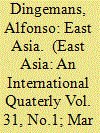

|
|
|
|
|
| Publication |
2014.
|
| Summary/Abstract |
East Asia is regarded in Chile as an opportunity to achieve economic development, because economic integration would place it in East Asia's value chains. This article suggests that the results of Chile's economic strategy toward East Asia, based on trade agreements, have had a predominantly quantitative success. The value of exports toward East Asia has indeed increased impressively. However, the qualitative results are less impressive. These agreements are not adequate to achieve structural change, which would enable the Chilean economy to move along East Asia's value chains. Statistical evidence confirms that Chile is still reduced to a commodity supplier and at the periphery of the chain. To change this situation, Chile has to design first a strategy of how to offer East Asia goods and services beyond commodities. This means looking beyond trade agreements.
|
|
|
|
|
|
|
|
|
|
|
|
|
|
|
|
| 3 |
ID:
161814
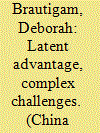

|
|
|
|
|
| Summary/Abstract |
Industrial policy is back on the African policy agenda, with a number of countries following new strategies for rapid industrialization. None have done so more eagerly than Ethiopia. The present paper draws on Justin Yifu Lin's framework of New Structural Economics to assess Ethiopia's industrial policies and engagement in the leather industry. Making use of two rounds of semi-structured interviews (2012 and 2015) with all of the foreign firms and more than a dozen local firms in the leather sector, as well as other key stakeholders, it examines seven steps the government took to build the industrial policy: Create a high-level focus on the sector; make strategic use of international development partners; attract a “lead goose” (Chinese) in the footwear sector; build government capacity to support the sector; strengthen business associations; “shock-to-shape” upgrading; improve input supply. Ultimately, while government interventions have led to improvements across several steps of the value chain, the paper identifies a number of factors that have prevented the country from fully realizing a latent comparative advantage in the leather sector.
|
|
|
|
|
|
|
|
|
|
|
|
|
|
|
|
| 4 |
ID:
149897
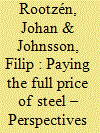

|
|
|
|
|
| Summary/Abstract |
This study examines the impacts felt downstream of carbon pricing and investments made in CO2 abatement within the steel industry. Using the supply of steel to a passenger car as a case study, the effects of a steel price increase on cost structures and price at each step of the supply chain were assessed. Since the prices of emission allowances under the European Union Emissions Trading System fall well below those required to unlock investments in low-CO2 production processes in the integrated steelmaking industry this paper seeks to pave the way for a discussion on complementary policy options. The results of the analysis suggest that passing on the compliance costs of the steel industry would have only marginal impacts on costs and prices for the end-use sectors (e.g., on the production cost or selling price of the passenger car). Under the assumptions made herein, at a carbon price of 100 €/tCO2, the retail price of a mid-sized European passenger car would have to be increased by approximately 100–125 €/car (<0.5%) to cover the projected increases in steel production costs.
|
|
|
|
|
|
|
|
|
|
|
|
|
|
|
|
| 5 |
ID:
147761
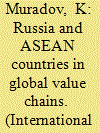

|
|
|
|
|
| Summary/Abstract |
USE OF TRADE STATISTICS is a normal way to evaluate economic cooperation between nations. Member countries of the Association of Southeast Asian Nations (ASEAN) are the destination of 1.8% of Russian exports and the source of 3.9% of imports into Russia.* Russia is the recipient of 0.4% of the total exports of the ASEAN countries and the source of 1.4% of their total imports.1 At first sight, these are modest statistics. But do they accurately reflect the nature of economic relations between, and the interdependence of, Russia and ASEAN nations in today's globalized world?
|
|
|
|
|
|
|
|
|
|
|
|
|
|
|
|
| 6 |
ID:
139479
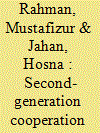

|
|
|
|
|
| Summary/Abstract |
South Asia remains one of the least integrated regions in the world, which is manifested in its lack of connectivity, low levels of intra-regional trade and weak investment flows. On the other hand, there is an apprehension that Southeast and East Asia could fall into a ‘middle income trap’, if they are not able to raise competitive strength and productivity further. In view of this, it is argued that there is a need for a framework of second-generation cooperation and integration embracing these three subregions in Southern Asia. This calls for concerted efforts to leverage existing institutional arrangements and put in place new avenues of subregional and inter-regional cooperation. Expansion of production networks, developments of value chains and greater integration of markets will allow these subregions to translate their respective comparative advantages into competitive advantages. Through harnessing opportunities of technology transfer, connectivity and greater factor mobility, and by taking advantage of cross-regional division of labour, these subregions could promote new patterns of inter-regional trade structure and specialization, which could benefit all the countries of Southern Asia.
|
|
|
|
|
|
|
|
|
|
|
|
|
|
|
|
|
|
|
|
|